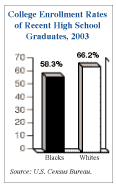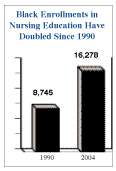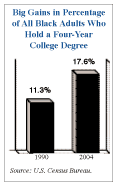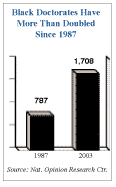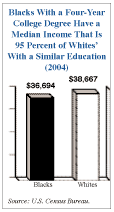| African Americans in Higher Education: Now for the Good News Don't be discouraged by recent setbacks in measures to advance African-American higher education. There has been important progress on many fronts.
Occasionally, readers complain that much of the content of The Journal of Blacks in Higher Education is punctuated with doom and gloom about the future of black opportunities and progress in higher education. News such as the retreat of race-sensitive admissions and outreach and orientation programs geared to blacks, and attacks on race-based scholarship awards is discouraging. But there is also much good news to report. Here is a sampling of positive developments on the progress of blacks in higher education that JBHE has reported for the first half of 2005: Enrollments • A new report from the U.S. Department of Education states that in 2002, the latest year for which complete data is available, there were 1,950,905 black students enrolled in higher education in the United States. This is the highest level of enrollments for African Americans in history. The nearly 2 million black students made up 11.5 percent of the 17 million students of all races enrolled in higher education programs in the United States. The important news is that although graduation rates continue to be low, in terms of college enrollments, blacks have achieved parity with whites. • There is good news too in black graduate school enrollments. In 2002, the latest year for which statistics are available, there were 170,241 African Americans enrolled in degree-granting graduate schools. This was an all-time high. Blacks were 8.4 percent of the total enrollments in U.S. graduate schools. • In enrollments, blacks are catching up to whites. A report from the Census Bureau shows that the racial college enrollment gap decreased from 9.6 percentage points in 2002 to 7.9 percentage points in 2003. Of the 333,000 African Americans who graduated from high school in 2003, 194,000, or 58.3 percent, had enrolled in college by the fall of that year. For whites, 66.2 percent of the 2003 high school graduates went on to enroll in college that fall. In 2002, 54.6 percent of black high school graduates enrolled in college the next fall compared to 64.2 percent of white high school graduates. • Older blacks are heavily enrolled in college. According to a report from the U.S. Census Bureau, 8.8 percent of the black population over the age of 18 was enrolled in higher education. In contrast, only 7.5 percent of all whites over the age of 18 were enrolled in higher education. This advantage in favor of blacks is due to the large number of older blacks who enroll in college. For the 30-to-34 age bracket, 8.4 percent of the total African-American population is enrolled in college. For whites, the figure is 6.6 percent. For adults over the age of 35, 2.5 percent of all blacks are enrolled in college compared to 1.7 percent of whites.
• At Vanderbilt University in Nashville, black first-year enrollments doubled from 70 in 1994 to 140 in 2004. Rice University, where black enrollments have fluctuated widely in recent years, showed an increase of 82 percent in the 1994 to 2004 period. • In 2005, the 70 black medical school students at Duke make up 15 percent of the student body. There are 75 black medical school students at Case Western Reserve University in Cleveland. They make up 12.3 percent of all students. Blacks are also more than 10 percent of the student body at high-ranking medical schools at Johns Hopkins University, the University of Michigan, and the University of Chicago. • In 2004, the latest year for which data is available, black applications to medical school increased by 2.3 percent from a year earlier. And black first-year enrollments in medical school increased by 2.5 percent. • In 1990 there were 8,745 African Americans enrolled in bachelor's degree programs in nursing in the United States. In 2004 the number of blacks in bachelor's degree programs in nursing reached a total of 16,278. Thus, black enrollments in undergraduate nursing programs have nearly doubled over the past 15 years. The progress has been even more spectacular at the graduate level. In 1990 there were 1,197 African Americans enrolled in master's degree programs in nursing in the United States. By 2004 the number of blacks in these graduate nursing programs had more than tripled to 4,096. • In the fall of 2004, 350 black students enrolled at the University of Michigan. This was down from 410 black freshmen in 2003, a drop of more than 14 percent. In 2004 blacks were 5.8 percent of the first-year class. Just three years earlier in 2001, blacks were more than 9 percent of all freshmen at the University of Michigan. Now, preliminary data from the office of admissions at the university points to a strong increase of more than 20 percent in black enrollments this coming fall. • In 2004 at the University of Illinois, black enrollments plummeted 32 percent. But the university reports that it expects black enrollments for this fall's entering class will be up 25.3 percent from a year ago. • In the fall of 2004 only 202 black freshmen enrolled at the flagship campus of the University of Georgia in Athens. They made up only 4.5 percent of all incoming students. Preliminary data suggests that the number of black students in the first-year class at the University of Georgia this year will be up more than 73 percent from a year ago. Degree Attainments • At the time of the Harlem Renaissance in the 1920s, at best 10,000 American blacks — one in 1,000 — were college educated. There are more than 3.8 million African Americans alive today who hold a four-year college degree.
• In 2004, 17.6 percent of all African Americans over the age of 25 held a four-year college degree. This figure has increased significantly from 13.8 percent in 1996 and 11.3 percent in 1990. • The U.S. Department of Education reports that in the 2002-03 academic year African Americans earned 237,615 degrees in higher education. This includes degrees at all levels from two-year associate's degrees to doctorates. Blacks earned 9.1 percent of all degrees earned that year. • A new report prepared by the National Opinion Research Center at the University of Chicago finds that 1,708 African Americans earned doctorates in 2003. This was an increase of 4 percent from 2002. The number of black doctorates in 2003 eclipsed the previous high annual total of 1,656 set in the year 2000. In 2003 blacks made up 6.5 percent of all doctorates awarded to American citizens. This, too, is an all-time high. • At the vast majority of the nation's leading medical schools, the black graduation rate is very high. In fact, at seven of the 14 schools that supplied graduation rate data by race to JBHE, the black graduation rate was a perfect 100 percent. At four additional high-ranking medical schools, the black graduation rate is 92 percent or higher. • According to the U.S. Census Bureau, the median black family income in the United States is 63 percent of the median white family income. But in 2003 blacks with a bachelor's degree had a median income of $36,694. This is 95 percent of the median income of whites with a bachelor's degree, which stood at $38,667. • About 28 percent of foreign-born black men in the United States have a four-year college degree. This is very close to the educational attainment figures for native-born white men in this country. • Eight years ago in 1997, only 33 percent of entering students at Alcorn State University, the historically black institution in Mississippi, went on to earn their diplomas. To increase its retention and graduation rates, Alcorn State created the College for Excellence. The mission of the school was to help freshman students adjust to college life. Students who are missing classes are given counseling. (A new program this fall will electronically monitor class attendance.) Tutoring sessions are arranged for students who are in danger of flunking out. Counselors are provided to assist students in choosing a major.
The results have been dramatic especially since 80 percent of Alcorn State students come from low-income families. The black student graduation rate at Alcorn State is now 48 percent. Good News on Black Faculty • According to a new report from the Department of Education, nationwide in 2003 there were 33,097 black full-time faculty at degree-granting institutions of higher education. • At the University of Virginia, 15 African Americans were offered tenure or tenure-track positions for the 2005-06 academic year and 11 of these black scholars accepted the offers. In 2004 only 31 percent of black scholars offered tenure or tenure-track positions decided to come to the University of Virginia. • In the spring of 2005 there were 98 blacks on the 2,524-member Duke faculty. Blacks made up nearly 4 percent of all faculty members. Over the past decade the number of black faculty members at Duke has increased by 94 percent. Since 1988 the number of blacks on the Duke faculty has more than tripled. • In 2005 blacks made up nearly 8 percent of the total faculty at Haverford College, which is located outside of Philadelphia. At Mount Holyoke College in Massachusetts, blacks are 7.7 percent of all faculty members.
• In 1999 blacks were 4 percent of the faculty at Vassar College in Poughkeepsie, New York. Now blacks are nearly 7 percent of the total faculty at the college. At Colgate University, the percentage of the total faculty who are black has increased from 4.0 percent in 1999 to 6.1 percent this year. In 2005 the California Institute of Technology hired two new black faculty members. This doubled the number of blacks teaching at the university. • According to a JBHE survey of black faculty at the nation's highest-ranked universities, only three of the 24 universities for which we have data experienced a drop in the percentage of blacks on their faculties over the past six years. The most impressive progress occurred at Vanderbilt University where the black percentage of the total faculty increased from 2.2 percent in 1999 to 4.3 percent in 2005.
Administrative Positions • In 2001, U.S. Department of Education statistics show that 13,720 African Americans held administrative posts at U.S. colleges and universities. They made up 9.4 percent of all administrators in American higher education. • Nationwide about 90 percent of all college and university presidents are white. But in the 14-campus state system of higher education in Pennsylvania, women and minorities make up a majority of the university presidents. And despite the fact that almost all of the state universities are in rural areas with small black populations, there are five black presidents among the 14 universities in the system. • A 2005 report from the Association of Governing Boards of Universities and Colleges found that blacks are 13.6 percent of all trustees at public universities and 7.6 percent of all board of trustee members at private institutions. All told, blacks hold 4,400, or 8.8 percent, of the approximately 50,000 trustee positions in American higher education. | |




